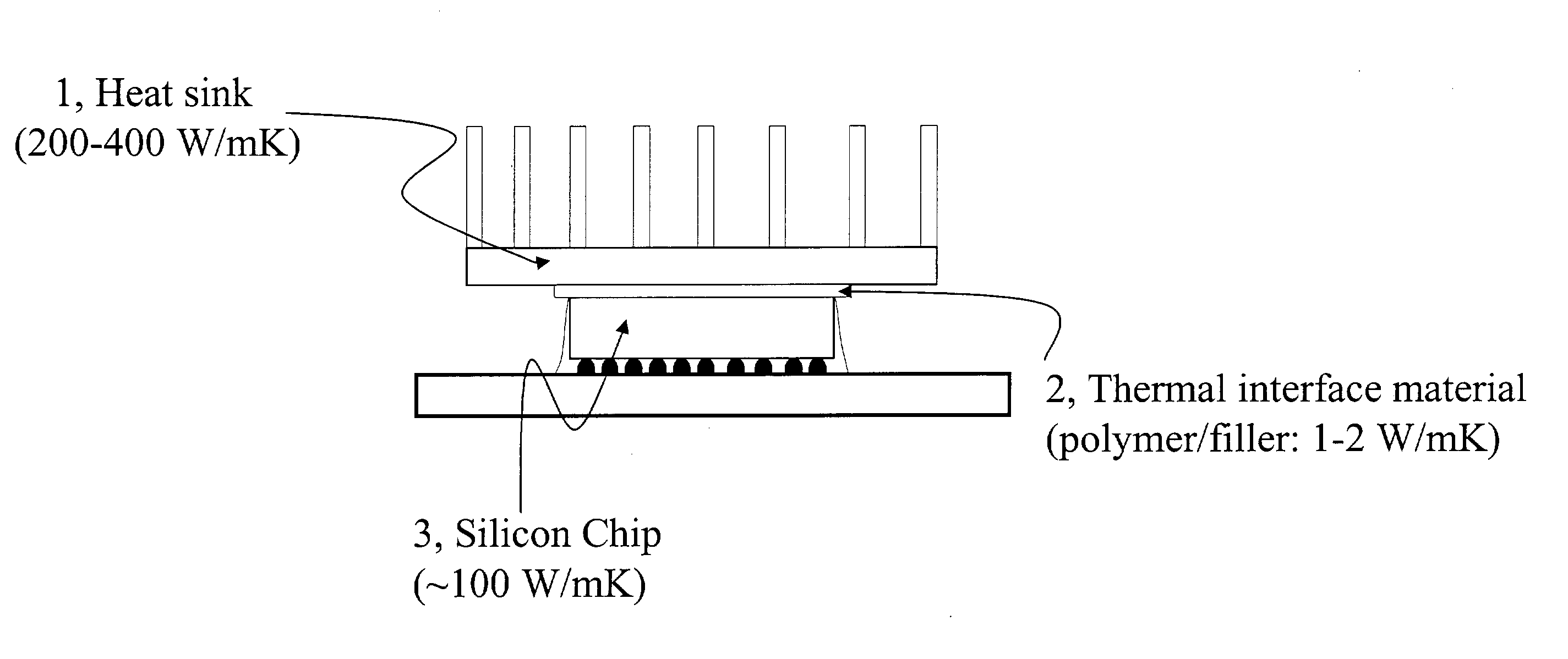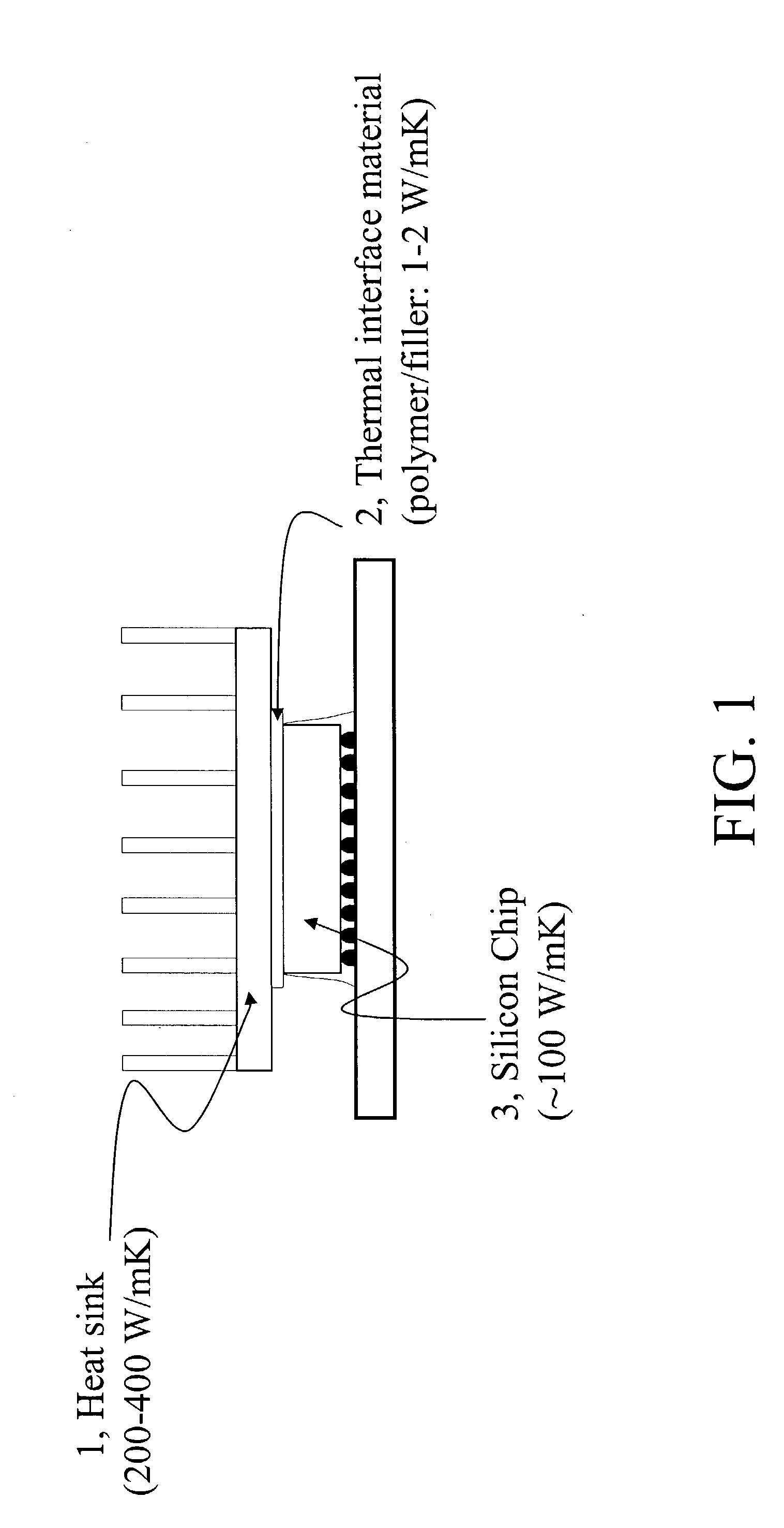Organic matrices containing nanomaterials to enhance bulk thermal conductivity
a technology of nanomaterials and organic matrices, which is applied in the direction of semiconductor/solid-state device details, lighting and heating apparatus, etc., can solve the problems of reducing the effectiveness and value of the heat sink as a thermal management device, reducing the ability to transfer heat through the interface between the surfaces, and permanent damage to electrical components, etc., to achieve the effect of increasing the efficiency of heat transfer
- Summary
- Abstract
- Description
- Claims
- Application Information
AI Technical Summary
Benefits of technology
Problems solved by technology
Method used
Image
Examples
example 1
[0042] A 4.95 g dispersion composition consisted of 31 wt % (wt % based on unfunctionalized colloidal SiO2) methacryloxypropyl-trimethoxysilane (“MAPTMS”) functionalized colloidal SiO2 (20 nm) acryloxy-terminated polydimethylsiloxanes (Gelest, DMSU22, MW˜1000-1200). Additionally, 2 g of MAPTMS, 0.13 g of iodonium salt (GE silicones, UV9380c) and 45.6 g of alumina (Showa Denka AS 10) were blended into the dispersion composition. The alumina added was 86.5 wt % of total formulation. The dispersion composition was cured at 120° C. The thermal conductivity of the dispersion composition was measured and found to be 2.6 W / m-K±0.05 at room temperature and 2.55 W / m-K at 100° C. Comparatively, the thermal conductivity of acrylates alone is approximately ˜1.4-1.9 w / m-K at 100° C. when filled with 86.5 wt % alumina (sized average size=38 microns). See Table 1.
example 2
[0043] A dispersion composition was blended of 1.82 g of octakis (dimethylsiloxy-T8-silsequioxane) (T8OSiMee2H, Gelest), 0.73 g of 1,5-hexamethyl-trisiloxane (MHDMH GE Silicones), 1.53 g of 1,3-divinyltetramethyldisiloxane (GE Silicone), 1.04 g of vinyl-terminated polydimethylsiloxanes (Gelest, MW 9400) DMSV22, a suitable catalyst and 20 g of alumina (Showa Denka, AS-40 and Sumitomo AA04). The alumina was added in approximately ˜80 wt % of the total formulation. The dispersion composition was cured at 80° C. The thermal conductivity of the dispersion composition was measured and found to be 1.99 W / m-K±0.15 at room temperature, and 1.70 W / m-K±0.10 at 100° C. Comparatively, the thermal conductivity for polydimethylsiloxane (“PDMS”) is approximately 1.00 W / m-K, when filled with 80 wt % alumina (average size=10 μm for AS40 and 0.4 μm for AA04). See, Table 1.
example 3
[0044] A dispersion composition was blended containing 7 g of GE Silicone product FCS 100 (containing 40 wt % MAPTMS-functionalized colloidal Si02 in 1,6-hexanediol diacrylate), 0.14 g of an iodonium salt (GE silicone, UV9380c) and 43 g of alumina (Showa Denka, AS50 and Sumitomo AA04). The alumina added was 86 wt % of the total formulation. The thermal conductivity of the dispersion was measured and found to be 3.35 W / m-K±0.20 W / m-K at room temperature and 3.25 W / m-K±0.15 at 100° C. Comparatively, the thermal conductivity of acrylates is approximately ˜1.4-1.9 w / m-K at 100° C. when filled with 86.5 wt % alumina (average size=10 μm for AS50 and 0.4 μm for Sumitomo). See, Table 1.
TABLE 1ThermalPolymer Matrix (wt. pts)conductivityColloidal SiO2aMicro-fillers(100° C.,Organic(size)(wt. pts.)bW / m-K)c 78 (acrylates)22 (20 nm)d6442.55 60 (acrylates)40 (20 nm)6443.25100 (acrylates) 06441.4-1.9 64 (silicones)36 (POSS. - T8HSiMe2)4001.7 100 (silicones) 04001.0 44 (epoxy)56 (20 nm)00.37100 (...
PUM
| Property | Measurement | Unit |
|---|---|---|
| weight % | aaaaa | aaaaa |
| weight % | aaaaa | aaaaa |
| particle size | aaaaa | aaaaa |
Abstract
Description
Claims
Application Information
 Login to View More
Login to View More - R&D
- Intellectual Property
- Life Sciences
- Materials
- Tech Scout
- Unparalleled Data Quality
- Higher Quality Content
- 60% Fewer Hallucinations
Browse by: Latest US Patents, China's latest patents, Technical Efficacy Thesaurus, Application Domain, Technology Topic, Popular Technical Reports.
© 2025 PatSnap. All rights reserved.Legal|Privacy policy|Modern Slavery Act Transparency Statement|Sitemap|About US| Contact US: help@patsnap.com


